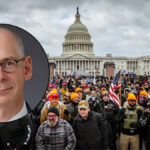
The Jan. 6 Committee voted unanimously Thursday to subpoena former President Donald Trump for testimony to the panel.
“A key task remains we must seek the testimony of the January 6 central player, ” Rep. Liz Cheney, the vice chairman of the Jan. 6 committee, said during Thursday’s hearing.
They vote, taken before a recess in the day’s hearing, came back 9-0.
Committee Chairman Bennie Thompson said in comments before the vote that Trump attempted “to replace the will of the voters with his will to remain in power.”
“He must be accountable,” Thompson said. “He is required to answer for his actions.
“He is required to answer to those police officers who put their lives and bodies on the line on January 6,” Thompson added, acknowledging that subpoenaing a former president “is an extraordinary action.”
Cheney, who lost her Wyoming re-election bid and will be leaving her congressional seat in January, added: “Our duty today is to our country and to our constitution,” Cheney said.
She said the committee also “has information to consider criminal referrals for multiple individuals” who enabled Trump on Jan. 6.
The committee also showed clips of Roger Stone arguing that Trump won the election and encouraging extreme Trump supporters to revolt. They played a video of Stone saying: “F— you. We won.”
The committee had returned from a long break for what’s to be a final time, and with what Thompson said would be “new evidence and testimony” showing how Trump had a multifaceted plan to overturn the 2020 election – even though he knew he’d lost it.
Going back to this spring, with the most recent hearing in July, the committee has laid out evidence and testimony from former aides in Trump’s administration in an attempt to show how his actions and tweets stoked the eruption of violence. Cheney said that Thursday’s hearing would be about Trump’s state of mind – what he knew, and what everyone around him was saying vs. what he claimed.
“The central cause of Jan. 6 was one man,” Cheney said. “Donald Trump.”
She said Trump sticking to his unfounded claims that the election was somehow stolen is “not a defense,” but is also simply not true.
Messages from the Secret Service have showed that agents were aware that some members of the mob had firearms, and that Trump wanted the crowd to be allowed into his rally near the Capitol without going through metal detectors.
“None of this is normal, or acceptable, or lawful in our Republic,” Cheney said.
Sen. Adam Schiff revealed Secret Service emails that indicated the agency was aware that groups like The Proud Boys were eyeing Jan. 6 for some kind of violent assembly; agents around the Capitol that day reported confirmed sightings of firearms, ballistic armor and other weapons before the attack began.
The Secret Service were “watching the crazies” and described a calm before the storm on the morning of Jan. 6, said Schiff, suggesting they knew what was coming. Schiff said the Secret Service “and other agencies” knew well in advance of the threats of violence.
Highlights from previous hearings :
Day 8. The July 21 hearing painted a picture of an uncaring President who watched the attack on TV – even as everyone around him knew he was the only one who could stop it. The hearing focused on 187 minutes of Jan. 6: from the moment Trump concluded his 1 p.m. rally at The Ellipse, urging his followers to march on the Capitol, until 4:17 p.m., when Trump finally released a video telling them to go home. Two Trump White House staff members — former deputy national security adviser Matthew Pottinger and former deputy press secretary Sarah Matthews — were on hand to detail that time period. Read about Day 8 highlights here.
Day 7 multiple witnesses testified on July 12 that a “heated and profane” fight at the White House raged for six hours on December 19 between Donald Trump’s competing factions of advisers. The result, the committee said, was Trump’s now-infamous “Be there, will be wild!” tweet the next day. The hearing also included videotaped testimony from a Twitter employee whose voice was obscured. The employee said he unsuccessfully implored his company to censor the president’s incendiary tweets, telling his superiors: “When people are shooting each other tomorrow, I will try and rest in the knowledge that we tried.” Read more about Day 7 here.
Day 6 on June 28 included the testimony of Cassidy Hutchinson, a former top White House aide, described for the committee a “furious” Donald Trump who threw dishes against the wall, ordered that rallygoers with weapons be allowed into his speech and physically tussled with his own security who refused to drive him to the Capitol building as the riot was getting underway. Read about Day 6 highlights here.
Day 5 on June 23 included testimony showing that Trump pressured on his own attorney general’s office to overturn the 2020 election – an effort one dissenting Justice Department official called a “murder-suicide pact.” The committee was expected to hear from a documentary filmmaker Alex Holder, who chronicled the final six weeks of the Donald Trump presidency, but Holder’s appearance was delayed. Read about Day 5 highlights here.
Day 4 on June 21 included Republican state officials from around the country telling the committee how Trump tried to pressure them to overturn election results, including sending supporters to officials’ homes, waving weapons and shouting insults and threats of violence. Read about Day 4 highlights here.
Day 3 kicked off June 16 with testimony focusing on the intense pressure President Trump put on Vice President Mike Pence to overturn the election. John Charles Eastman, an attorney and campaign advisor to Donald Trump and his election team, emerged as a key architect of the plan. Read about Day 3 highlights here.
Day 2 testimony on June 13 included new allegations of Trump campaign-donor fraud, former Attorney General Bill Barr saying Trump’s claims of a stolen election were “complete nonsense,” and tales of a drunken Rudy Giuliani offering election night advice, giving rise to “Team Rudy” and “Team Normal.” Read about Day 2 highlights here.
Day 1 on June 7 showed how Trump “summoned a violent mob” to pressure lawmakers to overturn the election results. The day included testimony from documentary maker Nick Quested, who filmed the Proud Boys storming the Capitol. Capitol police officer Caroline Edwards testified about how she tried to fight off violent protestors on Jan. 6. Read Day 1 highlights here.




















